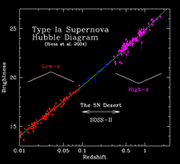 SEGUE:
The Sloan Extension for Galactic Understanding and Exploration
SEGUE:
The Sloan Extension for Galactic Understanding and Exploration
SEGUE will provide fundamental data (imaging
and medium-resolution spectroscopy) that will revolutionize our
present understanding of the formation and evolution of the Milky
Way galaxy. The most crucial information obtained with SEGUE will
be spectroscopy of some 250,000 individual stars in the Milky
Way, which will enable the identification and analysis of some
25,000 to 50,000 stars with metal abundances less than 1% of the
solar value (a sample 50 times larger than available today). Such
stars are of critical importance for understanding the production
and evolution of the first elements in the Galaxy (and in the
Universe). The data obtained by SEGUE will also enable studies
of the structure of all known structural components of the Milky
Way, including the stellar populations of the thin disk, the thick
disk, and the inner and outer halo. The modern picture of the
hierarchical assembly of the halo of the Milky Way from proto-dwarf
galaxies will be strongly constrained by these data.
JINA Co-Investigator Timothy C. Beers (astronomer,
Michigan State University, MSU) has coordinated the development
of analysis techniques that employ SDSS photometry and spectroscopy
to obtain estimates of the fundamental atmospheric properties
of stars, e.g., their effective temperatures, surface gravities,
and metal abundances. Based on these estimates, JINA scientists
will select stars of greatest interest for constraining the evolution
of the elements. These stars will, in turn, be studied at higher
spectral resolution using facilities at the Hobby-Eberly 9.2m
Telescope (HET) in Texas, with the Japanese National 8m Telescope
(Subaru) in Hawaii, with the Large Binocular Telescope (LBT) in
Arizona, with the Keck 10m telescope in Hawaii, and with the SOAR
4.1m telescope in Chile. Such high-resolution data will enable
the identification of large samples of stars that exhibit over-abundances
of neutron-capture elements, including the radioactive elements
Thorium and Uranium, which are of fundamental importance for developing
understanding of the same astrophysical processes that JINA is
studying with laboratory facilities at Notre Dame and MSU, and
by theoreticians seeking to understand the interactions of unstable
nuclei involved with production of the elements in the early Universe.
 SNS: Supernova
Search with SDSS-II
SNS: Supernova
Search with SDSS-II
Every fall during 2005-2007, the SDSS 2.5m telescope
will continuously scan 200 square degrees of the sky near the
south Galactic pole. This "movie of the sky" will reveal asteroids,
comets, Galactic variable stars, extragalactic supernovae and
bursts from active galactic nuclei. Supernovae are of special
interest. The SDSS-II survey will find explosions in the "supernova
desert": a distance range (0.1 < z < 0.3) that has seen very few
supernova discoveries. But SDSS-II has the unique ability
|
 |
to detect very faint events over a large search area and expects
find about 200 type Ia supernovae in the desert.
The SDSS-II supernova survey will:
1) use the supernova light curves to measure the properties of
dark energy that is accelerating the expansion of the universe.
2) study the diversity of supernovae and use that information
to make them better distance indicators and more reliable cosmological
probes.
3) match supernova characteristics with properties of their host
galaxies including metallicity, star formation rate and star formation
history. The large sample of SDSS-II events will provide clues
to the progenitors of thermonuclear supernovae and impact of environment
on the explosion energy.

